Nova – English Conversation School – Overview
Nova is one of the biggest English conversation school chains in Japan. In the few years up to 2005 Nova dominated the English conversation school industry in Japan with more than 50% market share.
The next few years were turbulent with its widely publicised bankruptcy in 2007 and negative publicity in the years following.
There are a lot of conflicting views and outdated information on the internet regarding Nova, so the goal of this post is to attempt to bring you up to date.
A Quick History of Nova
Nozomu Sahashi founded Nova Group in 1981. The first classroom was opened in Shinsaibashi, Osaka.
Nova expanded its number of schools as the business grew. It increased from 239 schools to 623 schools in 2004 alone. At that stage it had over 50% of market share.
In 2005 Nova lost ground in sales revenue. It posted net losses of 3 billion yen in the year 2005 and 2.4 billion yen in the year 2006 after the failed expansion attempt.
On June 13, 2007, the Ministry of Economy, Trade and Industry placed a 6-month ban against Nova soliciting long term contracts from students. This led to a large increase in refund claims and a drop in sales figures.
On 20 September, 2007, Nova announced that it was considering large scale closures of up to 200 branches.
The collapse of Nova left approximately 4,500 foreign staff and 2000 Japanese staff out of work.
As early as November, 2007, G-Communications announced that it was taking over the operations of the failed Nova Group.
G-Communications sold the Nova Chain in 2010.
Jibun Mirai Associe Co. LTD bought the Nova chain in 2012. However G-Communications still operates some Nova schools through its subsidiaries G-Networks and G-Taste.

My Experience at Nova
I worked at Nova from 2012 to 2016 in Matsuyama and Imabari cities in Ehime prefecture. During this time I experienced a lot of positive things about the company. I met and worked with some great people. Students and teachers were friendly and from a range of different backgrounds. The training and resources were good. But, I also experienced a lot of things that didn’t make a lot of sense, or that I couldn’t understand the reasoning behind. This of course, could be said about working for any Japanese company.
Despite some drawbacks, I still believe Nova to be a reasonable choice as a first English teaching job in Japan.
An Easy Entry Point to Japan
To be an Instructor at Nova you need two things; to be a native English speaker, and have a university degree in any subject.
For many people, Nova is their means of entry into Japan. There are always jobs available somewhere because of the size of the company and because of the high turnover rate. (I don’t intend this to sound negative, but that’s the nature of employing foreign staff).
As well as being a relatively easy way into Japan, they also look after you through the Visa process. As in, they take care of it for you.
If you get hired by Nova from outside Japan they will look after the Visa process. I was given the job when I was in New Zealand. The contract was sent to me to sign. With the signed contract and a few other documents; criminal record check, medical check, degree certificates etc, they went to Immigration and applied for my Certificate of Eligibility. When that was completed they posted it to me. All that was left for me to do was take the Certificate of Eligibility to the Japanese Embassy in New Zealand and get that changed into a Work Visa.
They Set You Up an Apartment
Nova will also set you up in an apartment if required, usually the case if you’re hired from outside Japan. The apartments are usually very small but clean and modern. I had a small choice between a few different apartments close to the school and that was all already set up when I arrived. Not set up with furniture, I mean the paperwork was set up, the key was ready.
I was set up in a Leopalace (nationwide accommodation provider), an apartment that I lived in for two years. It was 20 square metres. I had the option for more space but I chose the lower cost.
There are some photos below. In one of them I tried out my tent for Fuji Rock in the living space.
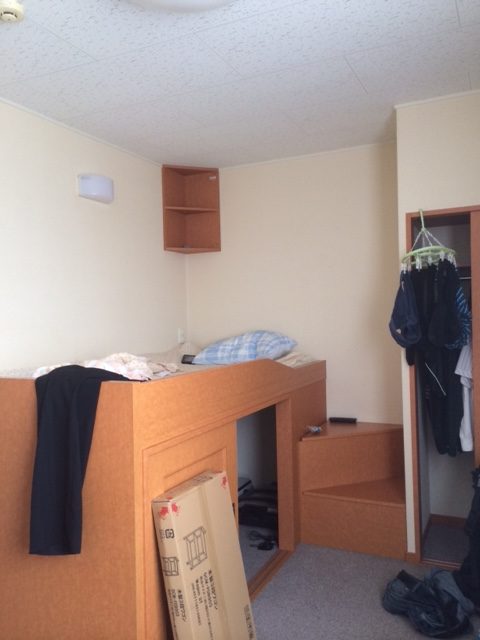
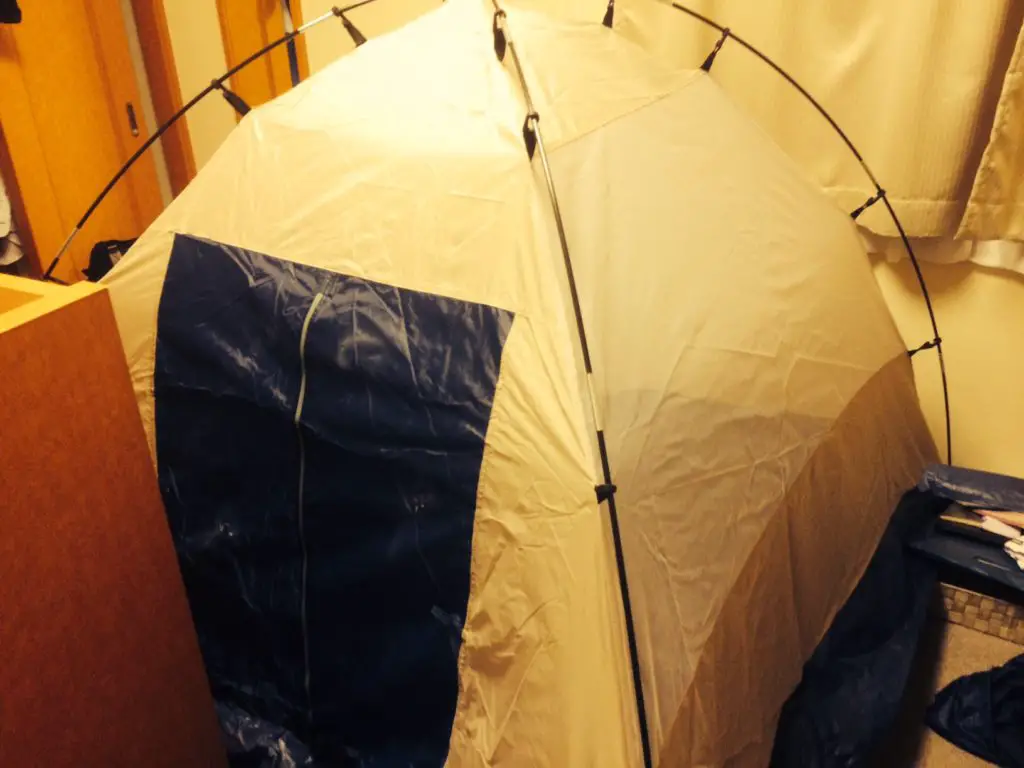
NB: Regarding Furnished Apartments
One thing that you need to know about these apartments is that when they say “furnished apartment” they mean it has a space for a futon, it doesn’t actually have any bedding. It does have a small fridge, a small table, a washing machine, a microwave, and a T.V. You have to supply your own futon. I’m not sure about other countries, but in New Zealand “furnished apartment” usually means more than the bare necessities for survival. Actual furniture, rather than just appliances.
The Negatives of a Low Standard of Hiring
So, Nova is a good and easy point of entry into Japan because they take just about anyone (if you’re a native speaker with a degree). Great when you’re looking for a job, but not so great when they’re providing your co-workers.
While working for Nova, I met a lot of passionate teachers who really enjoyed their jobs. Unfortunately, there are often (too often) instructors who have found a groove of doing just enough not to be fired. They realise that the company would rather keep them on than take a risk on an unknown quantity who they will have to pay to interview, hire, and train. The other thing that happens is somebody is hired who is completely unsuitable for the job.
A Bad Experience
The worst experience I had of this type was when I was working in a very small branch. Only three employees, one Japanese staff for branch management and sales, and two foreign instructors. My co-worker left and my managers (area managers) hired a woman from New Zealand. I was reasonably excited about this. Nova instructors are overwhelmingly male, and it was another person from New Zealand so I thought we’d get along well. She arrived and within five minutes of meeting her I knew that she wasn’t going to be able to do the job. The work isn’t difficult but you’ve got to be able to stand up in front of people and speak, and you’ve got to be able to lead and facilitate a conversation. I don’t know how to explain it but she was not going to be able to do any of those things. She was too timid, too unsure of herself.
Sure enough, complaints began coming in from students that she was getting through the material too quickly, she didn’t have the ability to expand upon anything, when she got to the end of what she was supposed to be teaching she didn’t have any idea what to say. She was scared of our branch manager so didn’t communicate with her, leaving me in the middle of them.
She lasted in the job about three months, before both she and management concluded that a mistake had been made and she returned to New Zealand. Don’t get me wrong, I don’t blame this poor woman at all. I do blame the person who had a Skype interview with her and decided she would be capable of doing the job.
Pre Job Start Training
There are a lot of posts in various online forums about the training that Nova offers. Some people saying it was good, some that it was totally inadequate for the work required. My own experience is that the training was really good, although a bit of a steep learning curve. The training was pretty intensive. I went to Okayama for three nights and three and a half days of training. They put me up in a cheap business hotel (pretty much a bed and a tv).
Day 1
The first day was half theory half practical. We covered company structure, teaching philosophy, introduction to the material, creating lesson plans. This was followed by some techniques to set up practice drills, and some aspects of lesson management focussing specifically on the second half of the lesson. All of this was one-on-one with your trainer. In the last lesson of the day was my first chance to teach a lesson. I co-taught a lesson with the trainer. The trainer taught the first half of the lesson and I taught the second half. I don’t remember the details of the lesson itself but I remember that it was pretty nerve wracking.
Day 2
On day 2 of your training you’re expected to teach two or three lessons interspersed with feedback sessions from your trainer and further training. Your trainer is generally in the room and can jump if you go majorly off track. The way this day is structured is that your trainer gives you quite a lot of help to plan and prepare for the first lesson. They expect you to plan your second lesson yourself but you’ve got 30 – 40 minutes to do it. And in your third lesson they try to recreate the general work environment where you’ve got ten minutes to see who your students are and to find and appropriate lesson for them and plan how to teach it.
Day 3
Day 3 was mainly troubleshooting anything that came up on day two. I was supposed to teach the last three lessons of the day, but there were a few no-shows and I had an easy time of it.
Kids Training
The last day was only a few hours and focussed on teaching kids lessons. One of the common complaints that I see about Nova training is how they don’t prepare you for dealing with the kids classes.
The training was one-on-one with the trainer who acted the kids parts. What you really learned was how to conduct a lesson in a perfect environment. The problem is that they can’t really simulate the problems that might occur in a kids lesson. You learned how to set-up drills, activities, and games. But it was very much as though it was an afterthought in the training.
Summing Up the Training
The training was way different to what I’d imagined. I had thought that you’d be mock teaching other staff members or at least volunteer students who knew that it was your first few days. But, students came in and my trainer had a quick word with them explaining that I was having training and I’d be taking the lesson but was it ok if he (the trainer) sat in the room. And I was teaching my first students. It felt crazy. But it’s the reality of the job. No matter how much time you spend preparing someone with theory or getting them to set up language drills, eventually they have to take the plunge and just do it by themselves. And in my experience since then, the earlier that happens the better.
Lesson Structure and Materials
This is one area where I believe Nova excels.
The lesson material is tied to exactly what Nova is trying to achieve as a school. This is huge. Even if you don’t agree with Nova’s overall educational philosophy, you have to admit that they’ve nailed what they set out to do.
In order to tell you what I mean by this, I need to give you some idea of the structure of a Nova lesson.
Lesson Structure
All lessons are 40 minutes long. This includes children’s and adult lessons, but I’ll focus on adult lessons for the rest of this section.
A 40 minute lesson is split into 4 sections (roughly ten minutes each) Listening, Language, Practice, and Production. The first half of the lesson, the Listening and Language sections, generally focuses on student input and the second half of the lesson, the Practice and Production, focuses on output.
Each lesson focuses on one main “takeaway point”. Often this is a specific piece of grammar, and often tied to a real-life situation. Perhaps a specific situation you might come across while travelling. Ordering food, checking-in to a hotel, buying medicine, going to a doctor. For example, there might be a lesson where the situation is that there is a problem in your hotel room. The TV is broken, you can’t work the air-conditioner, you don’t have enough towels. In this lesson the grammar might focus on making polite requests. Could you please send up some more towels? Is it possible for someone to fix the TV? etc…
It’s not really possible here to go any further into the nuts and bolts of the lesson. Suffice to say that I think this idea of making it abundantly clear to the student exactly what they are learning is a great idea.
Understanding and Articulating What You’ve Learned
It’s powerful to be able to articulate simply what you’ve learned in a particular lesson, even if it’s just to yourself.
Have you ever been studying something, any subject will do but perhaps a language more so, and someone asks you what you learned that day and you’re not able to answer? You know that you’ve learned something, you can think of what you’ve learned but you can’t articulate it into a succinct sentence. You can’t sum it up.
Nova’s goal is for the student to be able to say, in English or Japanese, today I learned how to check-in to a hotel. I was able to do it in a role-play situation without looking at the text book. And the student will be able to give clear examples of what language they used.
Materials
The materials are really good. Nova has 5 adult skill levels and for each skill level there are four seasonal textbooks of 50 lessons each. So there are 200 lessons per level, it should only be in extreme cases that a student can do 200 lessons without progressing a level.
As well as the textbooks that make up the core of the Nova curriculum, there are special units that a student can choose to take. These include beginner, intermediate, or advanced grammar: travel English: showing a foreigner around Japan. In order to take these special lessons the student must take a private lesson which is more expensive.
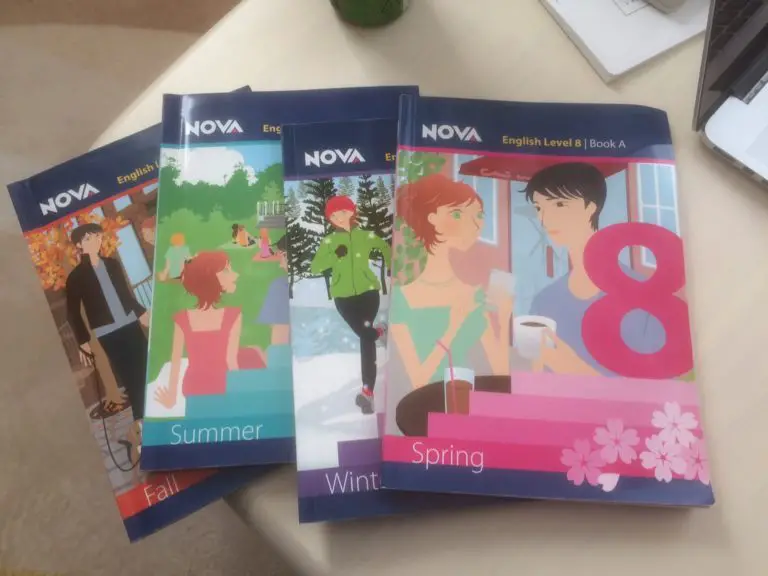
The Negatives of the Materials
The main negatives of the materials, and perhaps the lesson structure overall, is that it can start getting boring for the instructor.
I don’t want to put too much emphasis on this because, y’know, it is work. I’m sure it gets pretty boring greeting people at a McDonald’s counter all day as well. But, I guess that I want to make the point that as far as teaching goes there is not too much variation. In adult lessons at least.
There are a large amount of lessons, but you’re also teaching up to eight lessons per day. 40 lessons per week. 160 lessons per month. Where you are in Japan, and the general English ability in your area, will dictate the level that you teach the most. For me it was mainly the 2nd of the adult levels. So you end up teaching this level far more than the others. Certainly after two years, you’ve taught a lot of lessons several times.
But it’s also a little more than the content of the lessons. The tight and strict lesson structure means that you’re going through the same motions up to eight times a day. Introducing the lesson, setting up the listening, presenting the grammar, setting up the Practice, setting up the Production. It’s not really something that gets to you over days and weeks, but over months it can start to feel like you’re just doing the same thing over and over again.
100% Immersion
While a few of my co-workers found it frustrating not being able to use Japanese in class, I thought the 100% English immersion environment was a great thing, especially for kids. I think of it as a trade-off between short term convenience and long term gain. In order to see the true benefits of the immersion environment you’ve got to be with the same group of kids for a few years, and I was lucky enough to teach the same small group for about three years. As the kids get to know you, they want to tell you about stuff in their lives, things that happen at school, clubs, social life etc… Not necessarily as part of the class, but before and after the lesson.
Things like:
- Do you know the English teacher that comes to my school?
- My team won our soccer game.
- Do you have cars in New Zealand?
Because I never spoke Japanese in class. I don’t know if it ever occurred to them to try to ask me in Japanese. This was supported by the Japanese Branch Manager at that particular branch who did her best to make sure the whole school was a 100% English immersion environment (especially for kids). As much as that was possible.
Of course it was rare that my students were able to make a grammatically correct question or statement about something not directly out of their text. But they tried, and the fact that I was able to understand what they were talking about, showed them that they were about to communicate in English.
Time Between Lessons
This is another big source of complaints from Nova Instructors. The schedule is set up so you teach a 40 minute lesson, with 10 minutes between lessons. In that 10 minutes you’re expected to make notes from the lesson you just finished and choose the material for the next lesson. It’s tough, and when I was working there I thought it was unreasonable.
My current job, however, has shown me that the Nova schedule isn’t as unreasonable as I thought. I’m now working at an English conversation school that focusses on kids. Again, I only have 10 minutes between each lesson, but this time, as one group of kids walks out, the next kids are often walking in. This is because of a few things that Nova had in place that my new school does not.
- An area for students to wait until class starts
- An office area for Instructors
- Administrative staff that can keep the kids occupied for a few minutes while you prepare
So, what I thought was bad at the time is really just standard for the industry. And it could be worse. What I ended up doing at Nova was getting to work 30 – 40 minutes early so I could look at my lessons for the day and choose the materials. Sometimes there was a last minute cancellation or a student entered the class at the last moment and my selection had to be changed. But, for the most part, it made me feel better knowing that my next few lessons were already selected.
Being “On” 100% of the Time
Even more than the short amount of time between classes, I think that it is being “on” all the time that makes working at Nova so tough. The lessons are short and sharp. It’s expected that the student comes away from the lesson with knowledge that they are able to use immediately. Throughout the lesson there are points that you are expected to hit at certain times. Running a lesson in that way, can be tricky and tiring. There is a pressure to move on even if one student is not understanding the material. You can also have the opposite problem where one student understands it very quickly and is impatient to move onto the next step. Managing a class in this environment can be quite stressful. It’s a constant cycle of setting the lesson up, teaching the material and summing-up the material.
Cohesion Between Foreign and Japanese Staff
The way that Nova as a company is structured doesn’t encourage a good relationship between the Japanese staff and the foreign staff. The branches where I worked were small. In both branches there was one Japanese staff member (branch manager) who dealt with the administration of the branch, and also the local area promotion, and two foreign staff members. Myself and one other.
The company Nova is owned by Jibun Mirai Associe Co. LTD, but the administration of the branches was handled by other companies. And the foreign staff and the Japanese staff are not part of the same company. The foreign staff worked for G-Taste, and I can’t remember the name of the company that employed the Japanese staff, but it was not the same. Perhaps this is the only way to run a business that operates in different languages, but I could point out many examples of times where the Japanese and foreign staff were put into conflict because they’d been told different things.
An Example of Lack of Cohesion / Trust
The best example I can give of this happening is when management decided that it didn’t want the Instructors using social media on the branch computers during breaks. I think the general idea was fair enough, but the implementation of it was ridiculous. My co-worker and myself arrived at the start of a week to find that the internet wasn’t working on our computer. This meant that we were unable to access the Nova intranet system and get our lesson schedule for the day or any other student information. I went to the branch manager to tell her that our internet wasn’t working, and check if hers was alright. She told me her internet was fine and she didn’t know what was wrong with ours. My co-worker was much better with technology than me and he figured out that the internet had been disabled on the pc and he just enabled it again, thinking it was a problem with an update or an accident.
A few days later we got a memo down the chain through G-Taste, the company that employs the foreign staff, that the use of a number of websites had been banned. It continued that the Japanese branch managers had been instructed to come in at some stage over the weekend and disable the use of the internet except for certain sites that were needed to do our core operations. We were to go to our branch manager and request any other sites that we might want access to.
What had happened at our branch was that our branch manager either hadn’t been given the right instructions or just didn’t enable the sites that we actually needed. And we, not knowing any of this, just turned the internet back on.
I was pretty frustrated by all of this. Because I thought that our relationship with our branch manager was better than that. And the fact that management wanted to ban the use of social media didn’t justify going and disabling things behind our backs. But of course I was most upset that when I went to ask her about it she didn’t tell us.
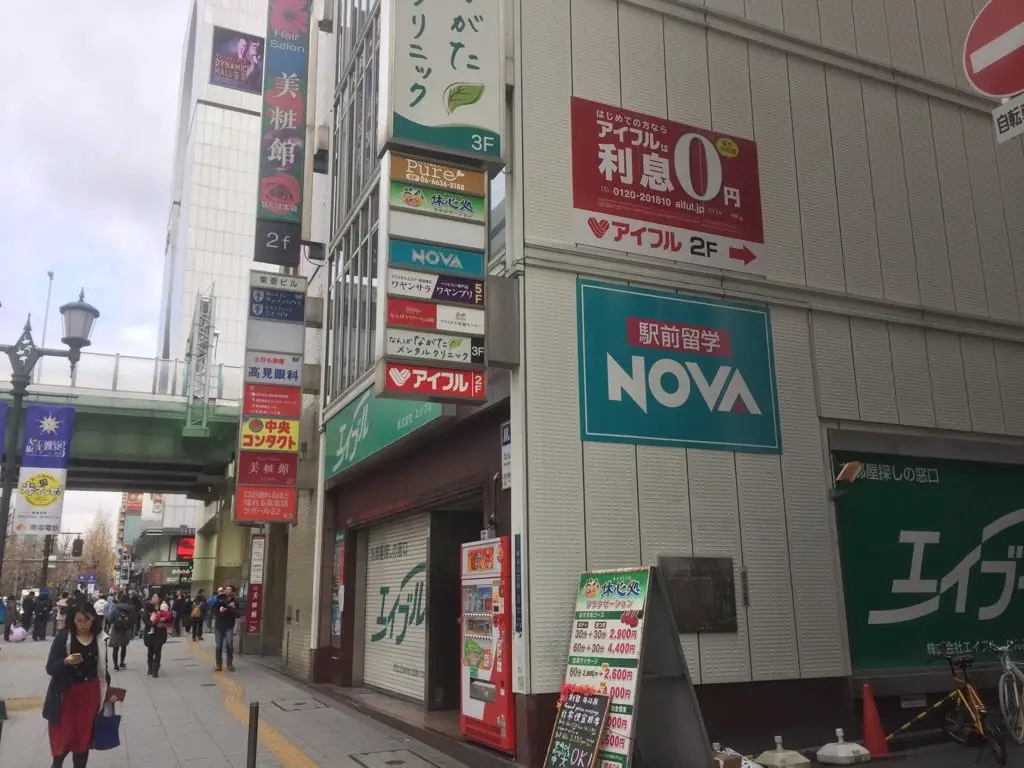
School vs Business
Nova struggles to be a good English conversation school because it’s in an awkward position between being a “school” and a business.
The best example that I can offer is this:
When a new student joins Nova, they are carefully level tested on 100 grammar and pronunciation points. How well they do on this placement test determines what level they are put in. Nova instructors are trained specifically on how to place a student within a level, and that is great.
However:
Every few months there is a drive to Level People up. Perhaps the company wants the boost in cashflow when suddenly a lot of students are paying for a “Level-Up Test”. Branches are given targets to meet in terms of giving students recommendations to take a Level-Up test and on how many people actually pass the test. During this time, pressure is put on instructors from the Japanese branch staff to Level-Up students that don’t make the required grade. Usually it is because a student has done a lot (200 +) of lessons in a level and the branch manager feels that they need to have some success. Or the branch manager feels like they will quit if they don’t succeed in going up a level.
Now, it’s a business, I can understand keeping the customer happy at the expense of the comfort of the staff. But it creates a flow-on effect of problems. The student goes up to a level they’re not ready for and has a difficult time. The other students in that level get annoyed because their lessons become slower to accommodate the new student. And the instructor is stuck doing a balancing act trying to keep everyone partly happy.
Teaching at Nova – English Conversation School
As I’ve said above, teaching at Nova has some issues, but I’m sure all English conversation schools do. The biggest challenge that I found was lack of communication between the Japanese Branch Managers and the instructors. Sometimes I was frustrated that Nova was such a business (as opposed to a school). But the bottom line is that it is a business and if it didn’t make money it wouldn’t exist.
What I’m saying is I’ve listed more negative things than positive in this post. Please don’t let that stop you from applying for a job with this company. It is a great way to get yourself set up in Japan and the ongoing training that I had is still paying dividends today. At times I had some co-workers who were less than ideal but I’m sure that’s true in most jobs. And because you’re teaching the classes alone their performance can never hinder yours.
If you’ve got the opportunity to go and teach in Japan, I would take it.
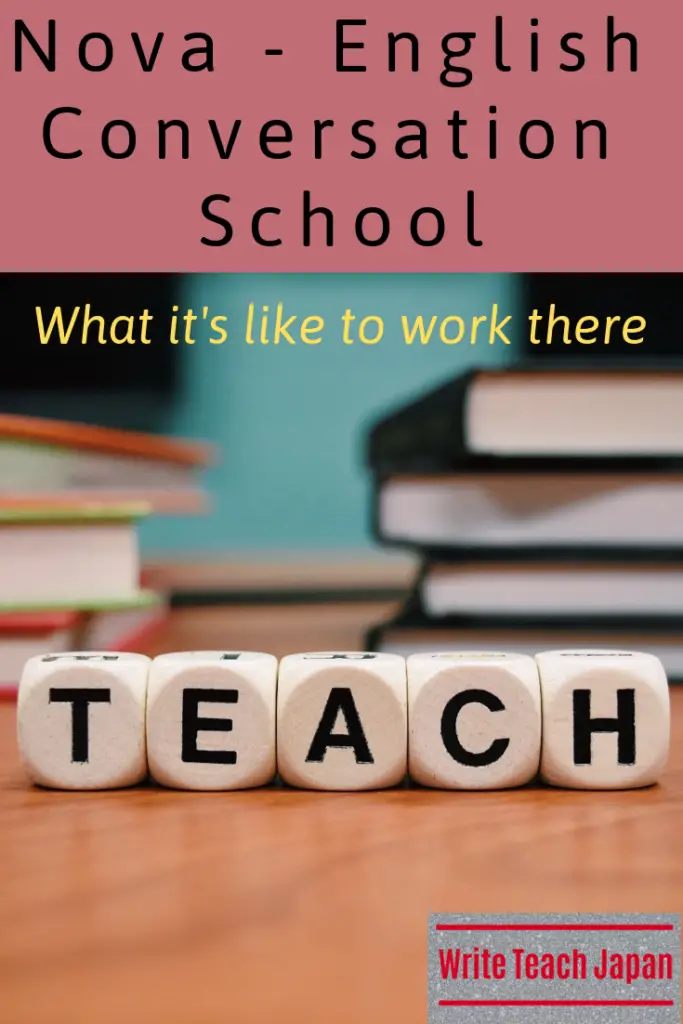
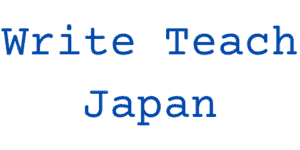
Well you don’t sound rude not to hire non natives but do u have an idea that there are non natives English fhay are really good?Have you guys tried us out? I surely think it’s everything to do with being black and not capabilities.